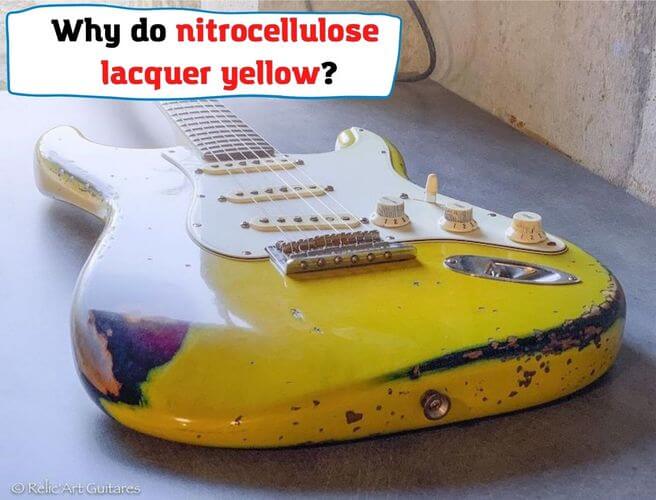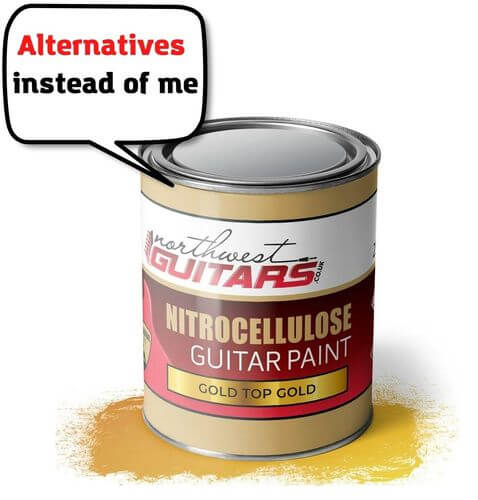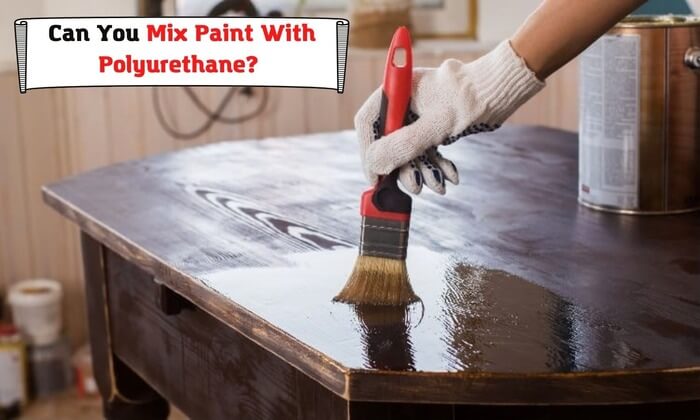
If you are working with wood, you may be concerned with the task to save the color from yellowing or from other changes over time. Sometimes lacquers yellow after you apply them and this may be OK for someone. For example, we’ve found some guys asking on special forums what to do to make their guitar finish yellow over time. But most of you will want the finish to stay the same all the time and not change at all. This is achievable if you follow the rules given below.
Today we’ll investigate the nitrocellulose lacquers and will look at them in terms of guitar finish as well as any other wood surface finish. We’ll see the aspect of yellowing which is extremely important for many people. Also, we’ll give some tips on how to save the color of your wooden surface without many expenses.
Here are the points we’ll discuss in today’s article:
- Why do nitrocellulose lacquers yellow over time?
- Which lacquer is best for guitar finish?
- How to save the color of your wood?
- How to apply nitrocellulose and other lacquers correctly?
- What to do if the results after applying the lacquer aren’t that good?
Let’s get started!
Yellowing lacquer – what’s wrong?
You have to note that some lacquers are made to yellow over time. And the nitrocellulose lacquer is one of them. The older the thing is, the more distinctive the yellowing will be. Nitrocellulose lacquers are notorious for yellowing, that’s why people who don’t want their wood to yellow over time never use it or mix it with some other materials.
Some guitar makers say that if you buy the lacquer with UV protection, the yellowing will not be as obvious. But with the nitrocellulose lacquer, it doesn’t work that way. You will still get significant yellowing over time. It will be actually noticeable in 8 or 10 years, but anyway. The pure nitro will yellow after two to five years or even sooner, depending on which lacquer you choose and what kind of wood you cover with it.
One more important factor is where you keep your guitar or any other wooden things covered with nitro. If it’s a guitar and it’s always kept in a cover that protects it from any sunlight, then the lacquer will be OK for a decade. If it’s a musical instrument that you often use in your camping trips and never store in a cover, the yellowing will occur in a year or two.
The UV rays are most often to be blamed for the yellowing color of any wooden surface that is covered with lacquer. Sometimes it’s all about the quality of the materials you use. In our article we’ll try to figure out what you should do in these two cases:
- You want your lacquer to yellow over time.
- You don’t want your lacquer to yellow over time.
So, let’s move on!
Why do nitrocellulose lacquer yellow?

Actually, this lacquer is made to naturally yellow over time. If you take some cheaper water-based lacquers, you won’t find anything like this. They will peel off in a year or two and won’t change their color naturally. The nitro lacquer will allow the wood under it to yellow and the lacquer itself changes the color after a couple of years. The change looks beautiful if you wanted the finish to yellow.
The more sunlight the finish gets, the faster it yellows. Sometimes people even get the lacquer to go yellow before applying it on their guitars or other things. For this, they put some lacquer into a jar, get it outside where it can get some sunlight. Then they forget about the jar for approximately a year. After that, the lacquer is naturally yellow and it can stain the wood naturally without any paint in it.
If you don’t want your lacquer to yellow over time, better choose some other options than a nitro. Even with all those UV protections, the nitro can go yellow in 5 years or more. Sometimes it looks good, but on white wood, it will look like the thing is very old and shabby.
How to fix it when nitro lacquer yellows?
You can basically do two things to save a wooden surface from yellowing:
- Clean off the nitro lacquer and get some other product to cover and polish your wood. This will take some time and effort, but the results will be quite good.
- Make a new clear coat of nitro. This will save the previous coats from yellowing, and the new coat will start yellowing in a couple of years.
Unfortunately, many manufacturers claim that their nitro lacquer doesn’t yellow because it has some UV protection in it. But the protection only gives you more time. Any nitrocellulose lacquer will yellow over time if exposed to the sun. So if you want your wood to keep the same color over years, choose some other finish.
What is nitro lacquer made of?
The nitrocellulose lacquer was introduced decades ago and it was used in many different spheres including car manufacturing. The paint was used by big music instrument manufacturers like Gibson to paint their guitars. This is probably why it is so popular now in the guitar industry. When some enthusiasts want to remaster their guitars, they think: “Oh, Gibson used nitro, so I will buy the same lacquer!”
But Gibson made it for some reason. This lacquer is really quick to dry. It keeps beautiful color for some years which is quite enough for selling a guitar. It is also cheaper than many other ways to paint the wood.
The lacquer is made of wood and cotton, nitric and sulfuric acids, thinned with solvents. This structure isn’t bad at all, but it will yellow over time whatever you do. Even the chemical UV-protection components don’t help much.
What alternatives of the nitro lacquer don’t yellow?

When it comes to finishing a guitar or any other wooden thing, you will have a big choice of materials. Of course, choosing the needed one won’t be easy at all. You’ll have to consider the type of surface you are going to cover, the effects that you want to get. We’ve investigated the market and have found some cool alternatives for the nitro lacquer.
Sher-Wood Water White Conversion Varnish
This material has good resistance to yellowing. And the manufacturer says about it in the documents. It ensures a water white color that will stay the same for quite a long time. The product is especially good for white-colored stains or just for light-colored wood.
Also, this product is relatively easy to work with. It’s safe for users isn’t that toxic and has solid UV protection. The same product can be used as a sealer if needed. Actually, Sher-Wood product is made for kitchen furniture finishes, but it will be good for any other purposes. The varnish has excellent moisture resistance which is good for things that are used outside.
Shellac
Well, this is a really good thing to turn your attention to if you are thinking about a new guitar finish. Shellac will give a natural wood look, it’s a natural product that consists of safe materials. No health issues are possible. Also, Shellac is really good in terms of lasting. This is a long-lasting material that won’t need any new coats or repairs for a long time.
Though, shellac is not water-resistant and heat-resistant. If you cover any wooden surface with Shellac, make sure it stays away from fire and also from humid conditions. Otherwise, your finish will peel off over time.
Acrylic lacquers
Acrylic materials are quite popular, some worldwide known producers use them when they make guitars. The material is really safe for a human because it doesn’t contain any solvent that could produce harmful fumes as in the case with nitro lacquer.
Acrylic lacquers are water-based materials that are synthetic and mixed with different additives to make them look really cool and last really long. The drying is very quick, so you won’t spend a lot of time making all those coats. Acrylic materials are much easier to apply than many other types of finishes. The only major disadvantage is the price. If you want to get a really good acrylic lacquer, you will need to pay a lot.
Final thoughts
Well, nitro lacquer isn’t that bad, especially when it’s new. But over time, this lacquer starts yellowing. And it has many other disadvantages like toxic fumes, wear and tear over time, cracking, complicated application, etc. So many of our readers will want to use some alternatives that are easier to apply, protected from yellowing, and don’t cost them a fortune. You can find these alternatives above in our article.
If you already have a guitar or any other wooden object that is covered with nitro, no need to worry. Most likely, the surface will be OK for more than two or three years. After that, you may want to get it repainted with other materials. The best choice is to wait until the lacquer starts yellowing or cracking and then have it repainted. Sometimes the nitro lacquer will yellow beautifully and naturally.
- Can You Unmix Paint: Techniques, Consequences, Alternatives - February 23, 2024
- Does Primer Need to be Mixed? Effective Primer Application - February 22, 2024
- How to Make Old Paint Usable Again: Retrieving and Preserving Paint - February 21, 2024



